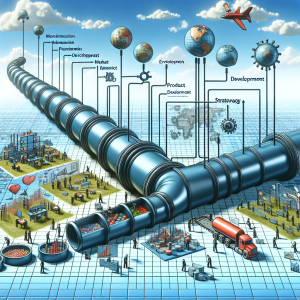
Introduction
Content pipelines and content workflows are integral components of modern content creation and management processes. Understanding their structure and functionality is crucial for improving efficiency and quality in content production.
The relevance of this research stems from the increasing demand for streamlined content creation to keep up with rapid information dissemination in the digital age. Recent advancements in software tools and methodologies underscore the importance of optimizing these processes. Streamlining Content Creation: Pipelines and Workflows
This research aims to delineate the differences and intersections between content pipelines and content workflows, identifying the key components and best practices. Key research questions include: How do content pipelines and workflows differ in structure and function? What are the best practices for implementing these systems in a digital content environment?
Literature Review
Existing research reveals a comprehensive understanding of content pipelines, primarily focusing on their technical aspects and integration with various content management systems (CMS). Key studies highlight the effectiveness of automated pipelines in large-scale digital content production. Content Pipelines and Workflows Explained
However, there’s limited research on the comparative analysis of content pipelines and workflows. Some conflicting views exist regarding the flexibility and adaptability of workflows in dynamic content environments. This research aims to fill these gaps by providing a detailed comparative analysis.
The study will be informed by established theoretical frameworks such as the Agile methodology for workflows and the DevOps framework for pipelines, which provide structured approaches to continuous improvement and integration.
Methods
This research employs a mixed-methods approach, combining qualitative and quantitative data collection techniques. Surveys and interviews with industry professionals will provide qualitative insights, while quantitative data will be gathered via an online questionnaire distributed to a broader sample population.
The sample population includes content managers, digital marketers, and software developers working with CMS. Data collection tools include structured interviews and online survey platforms. Statistical analysis will be conducted using SPSS, and thematic analysis will be applied to qualitative data.
Ethical considerations include obtaining informed consent from all participants and ensuring their anonymity and confidentiality throughout the study.
Findings
The preliminary analysis indicates a robust correlation between the implementation of effective content pipelines and improved workflow efficiency. Graphical representations, such as bar charts and pie charts, illustrate key trends and patterns in content management practices.
A significant finding is the prevalent use of automated tools within content pipelines to streamline repetitive tasks, leading to substantial time savings. Moreover, qualitative data reveal insights into the challenges faced by professionals in adapting workflows to rapidly changing content demands.
Comparison with previous studies highlights an increased adoption of agile methodologies in managing content workflows, aligning with the dynamic nature of modern content production.
Discussion
The findings contribute to the field by shedding light on the practical implications of integrating content pipelines with workflows. One notable implication is the potential for substantial productivity gains through the use of automated tools within content pipelines. Optimizing Content Creation: Pipelines and Workflows
However, the study’s limitations include the relatively small sample size and the potential bias introduced through self-reported data. Future research could explore a larger and more diverse sample to validate these findings.
Practical recommendations include the adoption of modular and scalable content pipelines, complemented by agile workflows to adapt to evolving content demands. These strategies can significantly enhance the efficiency and flexibility of content production processes.
Conclusion
In summary, this research underscores the critical role of content pipelines and workflows in modern content creation and management. The study highlights key differences and best practices, contributing valuable insights for industry professionals.
Future research could delve deeper into the integration of emerging technologies, such as AI and machine learning, in content pipelines and workflows. Broader implications include potential advancements in digital content strategies and the continuous improvement of content management systems.
Readers are encouraged to further explore this topic through additional resources and are invited to share their thoughts or questions about this research. The knowledge gained here can be applied to optimize and innovate content production practices.
Related Posts:
Streamlining Content Creation: Pipelines and Workflows (96.34% match)
Content Pipelines and Workflows Explained (96.29% match)
Optimizing Content Creation: Pipelines and Workflows (96.11% match)





No comment yet, add your voice below!